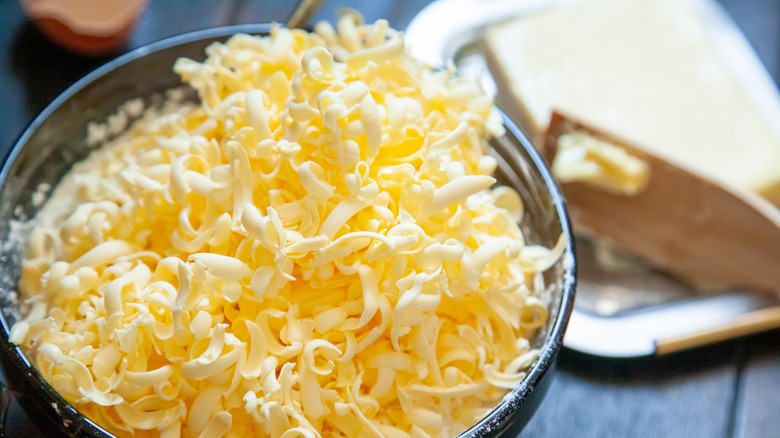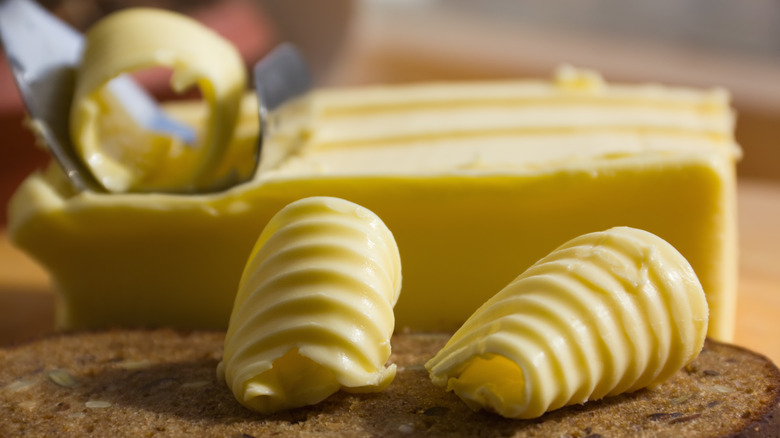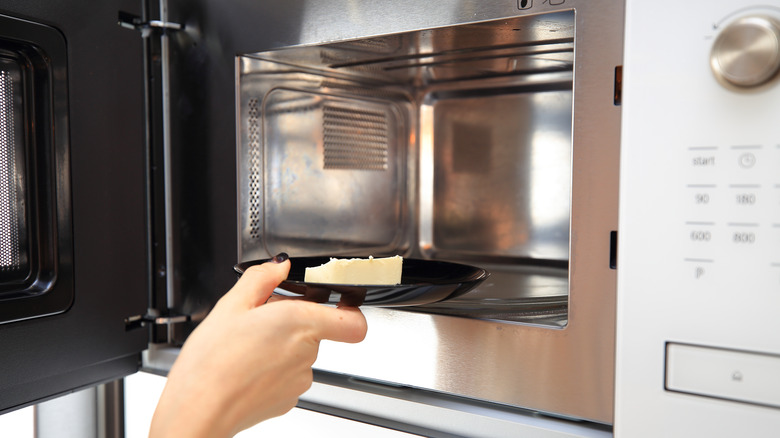The Grating Trick To Thaw Frozen Butter In A Hurry
Frozen butter can be useful if you're cooking a black and blue steak, but most of the time, it needs to be defrosted before you cook with it. What if you forget to take a stick out of the freezer, and now you're stuck waiting for it to defrost when you're supposed to be making cookie dough or buttering toast? You can solve that problem with a tool that's likely already in your kitchen: a cheese grater.
Grating frozen butter breaks it down into small, thin shreds, which are then able to melt much more quickly than a larger piece. If you need a certain amount of butter, you can use a heated knife to cut the right amount off the stick, or you can make a notch in the butter and grate until you reach that spot. You can also freely grate butter over toast, pasta, or potatoes for fast-melting, evenly-dispersed buttery goodness. Way easier than trying to slice and spread frozen butter, right?
This trick works for any type of butter, but be careful of your fingers as you grate. As a precaution against injury, you can leave the butter's wrapper on in the spot where you're holding the stick, and peel it back as needed. Avoid grating the stick all the way down to your fingers, and this method is pretty much foolproof.
How to thaw frozen butter without a grater
Cheese graters are an excellent tool for quickly breaking down frozen butter, but if you don't have one, there are a few alternative methods. Instead, you can use a vegetable peeler to gently "peel" thin slices of butter from the stick. This method works a lot like grating, as it makes pieces of butter that are small enough to melt quickly. Better yet, you get thin sheets of butter, as opposed to little shreds, so they're perfect for toast, grilled cheese, pancakes, and more.
Of course, some recipes won't work with shreds of butter. Pie crust, for instance, usually calls for cold butter that's cut into cubes. If you need an entire stick of butter thawed, you can try the water bath trick, which is similar to how you would thaw frozen meat. Fill a bowl or sink with room temperature water. Next, seal the stick of butter in an airtight bag, and place it in the water. Water transfers heat more efficiently than air, so this method is much faster than simply leaving a stick of butter to thaw on the counter. In as little as five minutes, the butter should be thawed enough to easily slice with a knife, but you can also leave it in the water longer to soften even more.
Why you shouldn't use the microwave to thaw butter
If you didn't know about the cheese grater or warm water tricks, you would probably head to the microwave to thaw your butter. After all, a few seconds of zapping are enough to get the butter soft, if not melted. However, the ease with which a microwave can melt butter is the exact reason you should avoid this appliance.
If butter is microwaved even a second too long, you're left with a molten puddle of goo, useful only in recipes that specifically call for melted butter. Even worse, microwaving might result in a stick of butter that's unevenly melted, with random cold blobs sitting in a puddle of goo. And what good is clumpy butter? You're much better off using a grater, or even softening butter with your oven's residual heat.
If you absolutely have to use the microwave, do so by microwaving in very small increments at a time, and at partial power, if you can adjust the setting. Rotate the butter between increments to encourage an even thaw, and remove the butter from the microwave the moment it's softened enough to slice.



